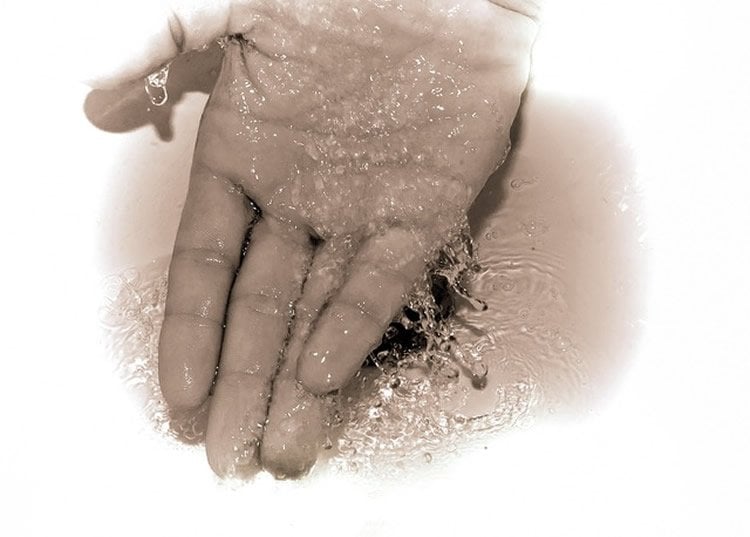Researchers develop the first neurophysiological model of how humans sense wetness.
Human sensitivity to wetness plays a role in many aspects of daily life. Whether feeling humidity, sweat or a damp towel, we often encounter stimuli that feel wet. Though it seems simple, feeling that something is wet is quite a feat because our skin does not have receptors that sense wetness. The concept of wetness, in fact, may be more of a “perceptual illusion” that our brain evokes based on our prior experiences with stimuli that we have learned are wet.
So how would a person know if he has sat on a wet seat or walked through a puddle? Researchers at Loughborough University and Oxylane Research proposed that wetness perception is intertwined with our ability to sense cold temperature and tactile sensations such as pressure and texture. They also observed the role of A-nerve fibers—sensory nerves that carry temperature and tactile information from the skin to the brain—and the effect of reduced nerve activity on wetness perception. Lastly, they hypothesized that because hairy skin is more sensitive to thermal stimuli, it would be more perceptive to wetness than glabrous skin (e.g., palms of the hands, soles of the feet), which is more sensitive to tactile stimuli.
Davide Filingeri et al. exposed 13 healthy male college students to warm, neutral and cold wet stimuli. They tested sites on the subjects’ forearms (hairy skin) and fingertips (glabrous skin). The researchers also performed the wet stimulus test with and without a nerve block. The nerve block was achieved by using an inflatable compression (blood pressure) cuff to attain enough pressure to dampen A-nerve sensitivity.

They found that wet perception increased as temperature decreased, meaning subjects were much more likely to sense cold wet stimuli than warm or neutral wet stimuli. The research team also found that the subjects were less sensitive to wetness when the A-nerve activity was blocked and that hairy skin is more sensitive to wetness than glabrous skin. These results contribute to the understanding of how humans interpret wetness and present a new model for how the brain processes this sensation.
“Based on a concept of perceptual learning and Bayesian perceptual inference, we developed the first neurophysiological model of cutaneous wetness sensitivity centered on the multisensory integration of cold-sensitive and mechanosensitive skin afferents,” the research team wrote. “Our results provide evidence for the existence of a specific information processing model that underpins the neural representation of a typical wet stimulus.”
Notes about this neuroscience research
Contact: Stacy Brooks – American Psychological Society
Source: American Psychological Society press release
Image Source: The image is credited to PublicDomainPictures and is in the public domain
Original Research: Full open access research for “Why wet feels wet? A neurophysiological model of human cutaneous wetness sensitivity” by Davide Filingeri, Damien Fournet, Simon Hodder, and George Havenith in Journal of Neurophysiology. Published online September 15 2014 doi:10.1152/jn.00120.2014
Why wet feels wet? A neurophysiological model of human cutaneous wetness sensitivity
Although the ability to sense skin wetness and humidity is critical for behavioral and autonomic adaptations, humans are not provided with specific skin receptors for sensing wetness. It has been proposed that we “learn” to perceive the wetness experienced when the skin is in contact with a wet surface or when sweat is produced through a multisensory integration of thermal and tactile inputs generated by the interaction between skin and moisture. However, the individual roles of thermal and tactile cues and how these are integrated peripherally and centrally by our nervous system is still poorly understood. Here we tested the hypothesis that the central integration of coldness and mechanosensation, as subserved by peripheral A-nerve afferents, might be the primary neural process underpinning human wetness sensitivity. During a quantitative sensory test, we found that individuals perceived warm-wet and neutral-wet stimuli as significantly less wet than cold-wet stimuli, although these were characterized by the same moisture content. Also, when cutaneous cold and tactile sensitivity was diminished by a selective reduction in the activity of A-nerve afferents, wetness perception was significantly reduced. Based on a concept of perceptual learning and Bayesian perceptual inference, we developed the first neurophysiological model of cutaneous wetness sensitivity centered on the multisensory integration of cold-sensitive and mechanosensitive skin afferents. Our results provide evidence for the existence of a specific information processing model that underpins the neural representation of a typical wet stimulus. These findings contribute to explaining how humans sense warm, neutral, and cold skin wetness.
“Why wet feels wet? A neurophysiological model of human cutaneous wetness sensitivity” by Davide Filingeri, Damien Fournet, Simon Hodder, and George Havenith in Journal of Neurophysiology, September 15 2014 doi:10.1152/jn.00120.2014.






